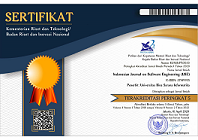Analisa Dampak Penggunaan Sistem Conference Dalam Mendukung Pembelajaran Daring
Abstract
Abstrak
Sistem Pembelajaran daring selama masa pandemi Covid-19 merupakan mekanisme pembelajaran pendidikan yang diterapkan oleh hampir seluruh negara di dunia dari tingkat pendidikan dasar hingga perguruan tinggi.Permasalahan yang dihadapai secara mayoritas adalah terkait effektivitas dan kualitas yang dapat diperoleh oleh anak didik selama mengikuti pembelajaran daring.Kesulitan, hambatan dan juga terkait masalah teknis seperti jaringan sering membuat pembalajaran menjadi tidak maksimal karena adanya perbedaan dari salah satu yang banyak dibahas yaitu daya tangkap setiap anak didik yang berbeda-beda dan juga antusiasme dalam pengawasan pembelajaran menjadi kendala yang harus diperhatikan. Dalam melaksanakan penelitian ini, peneliti menggunakan metode analisa Strength, Weakness, Opportunities, Threats (SWOT) dan juga metode penilaian balance scorecard. Analisa yang digunakan memiliki tujuan utama untuk mengetahui seberapa besar parameter dari penilaian yang dilakukan memberikan hasil terkait dengan apakah ada kelebihan, kelemahan, peluang dan gangguan dari dilakukannya pembelajaran daring terhadap anak didik yang sudah berjalan selama pandemi COVID-19 serta melakukan akumulasi dari nilai ukur yang dilakukan dari kumpulan pertanyaan kuesioner yang diberikan kepada sejumlah anak dan orang tua untuk mengetahui suara hati dari peserta didik yang terlibat. Hasil dari analisis dilihat dari perhitungan analisa teknikal dan juga response yang mayoritas menunjukan angka diatas 4 dengan nilai maksimal adalah 5 telah menunjukan sebagian besar mayoritas anak didik tidak terbiasa dengan mekanisme proses pembelajaran daring karena berbagai hambatan seperti daya tangkap khususnya pelajaran yang bersifat praktek, waktu yang tidak sesuai hingga kondisi jaringan yang terputus dan ketika tersambung kembali pembelajaran sudah tertinggal dan self learning yang tidak berjalan effektif karena faktor lingkungan.
Kata kunci: Sistem Pembelajaran Daring,SWOT, Balance Scorecard
Abstract
Online Learning System in this era of Covid-19 pandemic is one of the learning mechanism adopted by majority education institute of all country in the world from the junior level until university. Much problem faced by majority is about effectivity and quality for the student who has faced this mechanism. Difficulty level, obstacle and also technical problem like network ofted make learning is not going to reach maximum level because every student have different comprehension and enthusiasm for learning monitoring become obstacle that must have attention to settle it. On this research, researcher is using Strenght, Weakness,Opportunities, Threats (SWOT) analyst method and also balance scorecard method for report calculation. This analyst have a main purpose to have knowledge about impact of parameter for assessment that have been done to give result if strength, weakness, opportunites and threat have a impact for student are going to this mechanism in the COVID-19 pandemic and do accumulation measuring value from the questioner that have been distributed to student and parents get involved in this research, this questioner will be mirroring sound from the heart inside of participants. The result of this analyst is to show majority of students is used to have learning offline and feel uncomfortable if have learning by online mechanism because many problem like comphrehension difference, frustation in the field like practice, time suitability until network lost problem and when back connected study is already going far and self learning doesn't run effective because of environment factor
Keywords: Online Learning System, SWOT, Balance Scorecard
Full Text:
PDFReferences
Akhtar, S., Warburton, S., & Xu, W. (2017). The use of an online learning and teaching system for monitoring computer aided design student participation and predicting student success. International Journal of Technology and Design Education, 27(2), 251–270.
Fardani, I., Agustina, I. H., & Jauzi, F. A. (2020). Implementing SWOT analysis in engineering education. IOP Conference Series: Materials Science and Engineering, 830(3), 1–6.
Hew, K. F., Jia, C., Gonda, D. E., & Bai, S. (2020). Transitioning to the “new normal” of learning in unpredictable times: pedagogical practices and learning performance in fully online flipped classrooms. International Journal of Educational Technology in Higher Education, 17(1).
Ismail, I. I., Abdelkarim, A., & Al-Hashel, J. Y. (2021). Physicians’ attitude towards webinars and online education amid COVID-19 pandemic: When less is more. PLoS ONE, 16(4 April), 1–15.
Mushkarova, O., Mikheeva, M., Nefedova, I., Chepic, F., & Vasiliev, S. (2021). SWOT matrix analysis of the enhancing the effectiveness of education in the context of digitalization. IOP Conference Series: Earth and Environmental Science, 806(1), 012023.
Nandi, D., Hamilton, M., & Harland, J. (2015). What Factors Impact Student – Content Interaction in Fully Online Courses. International Journal of Modern Education and Computer Science, 7(7), 28–35.
Nash, C. (2020). Report on Digital Literacy in Academic Meetings during the 2020 COVID-19 Lockdown. Challenges, 11(2), 20.
Nasution, A. K. P., Surbakti, A. H., Zakaria, R., Wahyuningsih, S. K., & Daulay, L. A. (2021). Face to Face Learning vs Blended Learning vs Online Learning (Student Perception of Learning). Journal of Physics: Conference Series, 1783(1), 1–7.
Purarjomandlangrudi, A., & Chen, D. (2019). A causal loop approach to uncover interrelationship of student online interaction and engagement and their contributing factors. Research in Learning Technology, 27(1063519), 1–16.
Rotchanakitumnuai, S. (2013). Assessment of e-procurement auction with a balanced scorecard. International Journal of Physical Distribution and Logistics Management, 43(1), 39–53.
Sobaih, A. E. E., Hasanein, A. M., & Elnasr, A. E. A. (2020). Responses to COVID-19 in higher education: Social media usage for sustaining formal academic communication in developing countries. Sustainability (Switzerland), 12(16), 1–19.
Stephen, J. S., & Rockinson-Szapkiw, A. J. (2021). A high-impact practice for online students: the use of a first-semester seminar course to promote self-regulation, self-direction, online learning self-efficacy. Smart Learning Environments, 8(1).
Tyaningsih, R. Y., Arjudin, Prayitno, S., Jatmiko, & Handayani, A. D. (2021). The impact of the COVID-19 pandemic on mathematics learning in higher education during learning from home (LFH): Students’ views for the new normal. Journal of Physics: Conference Series, 1806(1), 1–8.
DOI: https://doi.org/10.31294/ijse.v7i2.11398

This work is licensed under a Creative Commons Attribution-NonCommercial-ShareAlike 4.0 International License.
ISSN : 2714-9935


Published by LPPM Universitas Bina Sarana Informatika
Jl. Kramat Raya No.98, Kwitang, Kec. Senen, Kota Jakarta Pusat, DKI Jakarta 10450
This work is licensed under a Creative Commons Attribution-ShareAlike 4.0 International License









